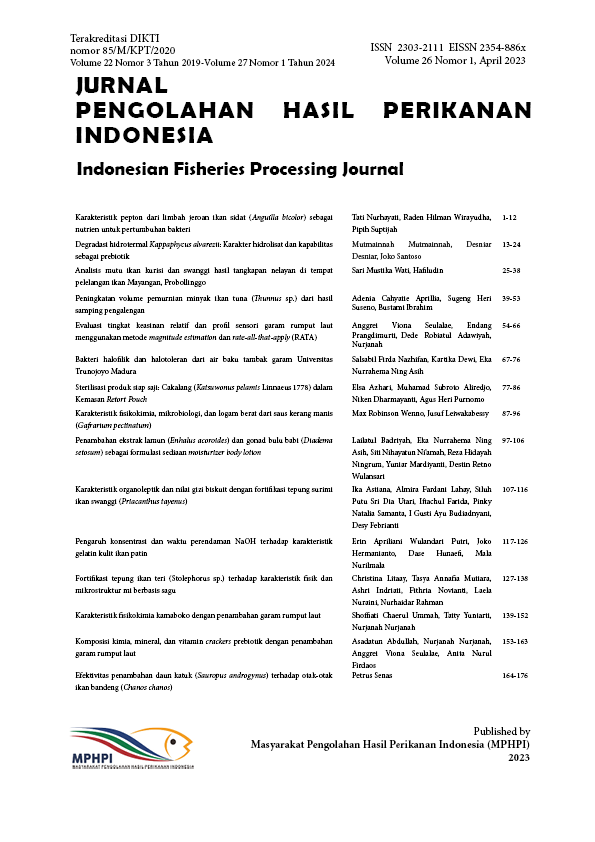Bakteri halofilik dan halotoleran dari air baku tambak garam Universitas Trunojoyo Madura Halophilic and halotolerant bacteria from raw water of salt ponds of Trunojoyo University Madura
Abstract
Halophiles are bacteria that require specific salt concentrations to survive, while halotolerants are bacteria that grow in the absence of salt and in the presence of high salt concentrations. Both halophiles and halotolerant bacteria have potential biotechnological applications. The aim of this study was to isolate moderate halophiles and halotolerant bacteria from the raw water of salt ponds at Trunojoyo Madura University and to determine their morphological and biochemical characteristics. Four halophilic bacterial isolates with codes AB.1.2, AB.2.4, AB.2.5, and AB.3.6, and two isolates of halotolerant bacteria with codes AB.1.1 and AB.2.3, were obtained. All isolates were coccus shaped, and most of the isolates were gram-negative. Three isolates were identified as aerobic bacteria based on catalase and oxidase tests. Only halotolerant bacteria AB.1.1 and AB.2.3, showed positive results in the citrate utilization test, while halophiles AB1.2, AB.2.5, and AB.3.6, showed positive results in the urease test. All isolates, both halophiles and halotolerant, were able to utilize sucrose, glucose, mannitol, and maltose.
References
Agustina, N., Asih, E. N. N., & Kartika, A. G. D. (2022). Jenis gram dan morfologi koloni bakteri air baku garam. Jurnal Ilmu Kelautan Lesser Sunda, 2(1),1-8.
Arisandi, A., Wardhani, M. K., Badami, K., & Sopiyanti, A. (2017). Pengaruh perbedaan salinitas terhadap viabilitas bakteri Pseudomonas spp. Jurnal Ilmiah Rekayasa, 10(1), 16-22.
Budiharjo, R., Sarjono, P. R., & Asy’ari, M. (2017). Pengaruh konsentrasi NaCl terhadap aktivitas spesifik protease ekstraseluler dan pertumbuhan bakteri halofilik isolat bittern tambak garam Madura. Jurnal Kimia Sains Dan Aplikasi, 20(3),142-145.
Canseco, J. H., Cruz, A. B., Mendosa, S. S., Balanos, T. A., & Patricia, S. S. M. (2022). Plant growth-promoting halobacteria and their ability to protect crops from abiotic stress: An eco-friendly alternative for saline soils. Agronomy, 12(4),1-22.
Dajoh, T., Bara, R. A., Angkouw, E., Ongku, M., Lintang, R. A. J., & Lumenta, C. (2020). Uji aktivitas antibakteri dan anti UV Phyllidiella nigra dan bakteri simbiotiknya dari Perairan Tanjung Mandolang. Jurnal Pesisir dan Laut Tropis, 8(2), 61-71.
Dewi, K., Pringgenis, D., Haeruddin, & Muchlissin, S. I. (2018). Fenomena bioluminesensi (Harpadon nehereus) berasal dari bakteri luminesen. Jurnal Pengolahan Hasil Perikanan Indonesia, 21(3), 451-459.
Dewi, K., Asih, E. N. N., Fitri, D. A., & Astutik, S. (2022). Karakterisasi fisiologis isolat bakteri halofilik dari kolam Peminihan tambak garam rakyat di Kabupaten Pamekasan. Juvenil, 3(3), 79-84.
Dussault, H. P. (1955). An improved technique for staining red halophilic bacteria. J. Bacteriol, 70(1), 484–485.
Fallo, G., & Sine, Y. (2016). Isolasi dan uji biokimia bakteri selulotik asal saluran pencernaan rayap pekerja (Macrotermes spp.). Jurnal Pendidikan Biologi, 1(2), 27-29.
Fitri, D. A., Asih, E. N. N., Kartika, A. G. D., Agustina, N., Fadholi, B., Dewi, K., & Effendy, M. (2022). Morphological characteristics of halophilic bacteria in traditional salt production. Journal Of Marine Resources And Coastal Management, 3(1), 1-7.
Fitri, L. & Yasmin, Y. (2011). Isolasi dan pengamatan morfologi koloni bakteri kitinofilik. Jurnal Ilmiah Pendidikan Biologi Edukasi, 3(2), 20-25.
Gaffney, E. M., Simoska, O., & Minteer, S. D. (2021). The use of electroactive halophilic bacteria for improvements and advancements in environmental high saline biosensing. Biosensors, 11(1), 48-55.
Marihati, Harihastuti, N., Muryati, Nilawati, Eddy, E., & Danny, W. H. (2014). Penggunaan bakteri halofilik sebagai biokatalisator untuk meningkatkan kualitas dan produktivitas garam NaCl di meja kristalisasi. Jurnal Riset Industri, 8(3),191-196.
Marzuki, I. (2019). Aplikasi mikrosimbion spons dalam bioremediasi lingkungan. CV. Tohar Media.
Nilawati, Marihati, Susdawanita, & Setianingsih, N. I. (2015). Kemampuan bakteri halofilik untuk pengolahan limbah industri pemindangan ikan. Jurnal Riset Teknologi Pencegahan Pencemaran Industri, 5(2), 23–28.
Pulungan, A. S. & Tumangger, D. E. (2018). Isolasi dan karakterisasi bakteri endofit penghasil enzim katalase dari daun buasbuas (Premna pubescens Blume). Jurnal Biologi Lingkungan, Industri, Kesehatan, 5(1), 72-80.
Rahman, S. S., Sidique, R., & Tabassum, N. (2017). Isolation and identification of halotolerant soil bacteria from coastal Patenga Area. BMC Research Note, 10(1), 1-6.
Rathakrishnan, D., & Gopalan, A. K. (2022). Isolation and characterization of halophilic isolats from indian salterns and their screening for production of hydrolitic enzymes. Elsevier, 6(1), 1-10.
Sari, D. P., Amir, H., & Elvia, R. (2020). Isolasi bakteri dari tanah tempat pembuangan akhir (TPA) air sebakul sebagai agen biodegradasi limbah plastik polyethylene. Jurnal Pendidikan dan Ilmu Kimia, 4(2), 98-106.
Sunatmo, T. I. (2007). Eksperimen Mikrobiologi dalam Laboratorium. Penerbit Ardy Agency.
Tiquia, S. M., Davis, D., Gadid, H., Kasparian, S., Ismail, M., Sahly, R., Shim, J., Singh, S., & Murray, K. S. (2007). Halophilic and halotolerant bacteria from river waters and shallow groundwater along the Rouge River of southeastern Michigan. Environmental technology, 28(3), 297–307. https://doi.org/10.1080/09593332808618789
Ventosa, A., Nietto, J. J., & Oren, A. (1998). Biology of moderately halophilic aerobic bacteria. Microbiol Mol Biol. Rev, 62(2), 504-544.
Volk, W. A., & Wheeler, M. F. (1993). Mikrobiologi Dasar. Erlangga.
Waluyo, L. (2007). Mikrobiologi umum. UMM Press.
Wantania, L. L., Ginting, E. L., & Wullur, S. (2016). Isolasi bakteri simbion dengan spons dari Perairan Tongkeina, Sulawesi Utara. Jurnal LPPM Bidang Sains dan Teknologi, 3(1), 57-65.
Authors

This work is licensed under a Creative Commons Attribution 4.0 International License.
Authors who publish with this journal agree to the following terms:
- Authors retain copyright and grant the journal right of first publication with the work simultaneously licensed under a Creative Commons Attribution License that allows others to share the work with an acknowledgement of the work's authorship and initial publication in this journal.
- Authors are able to enter into separate, additional contractual arrangements for the non-exclusive distribution of the journal's published version of the work (e.g., post it to an institutional repository or publish it in a book), with an acknowledgement of its initial publication in this journal.





